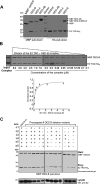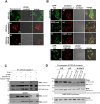Insights into the mechanism of human papillomavirus E2-induced procaspase-8 activation and cell death
- PMID: 26906543
- PMCID: PMC4764946
- DOI: 10.1038/srep21408
Insights into the mechanism of human papillomavirus E2-induced procaspase-8 activation and cell death
Abstract
High-risk human papillomavirus (HR-HPV) E2 protein, the master regulator of viral life cycle, induces apoptosis of host cell that is independent of its virus-associated regulatory functions. E2 protein of HR-HPV18 has been found to be involved in novel FADD-independent activation of caspase-8, however, the molecular basis of this unique non-death-fold E2-mediated apoptosis is poorly understood. Here, with an interdisciplinary approach that involves in silico, mutational, biochemical and biophysical probes, we dissected and characterized the E2-procasapse-8 binding interface. Our data demonstrate direct non-homotypic interaction of HPV18 E2 transactivation domain (TAD) with α2/α5 helices of procaspase-8 death effector domain-B (DED-B). The observed interaction mimics the homotypic DED-DED complexes, wherein the conserved hydrophobic motif of procaspase-8 DED-B (F122/L123) occupies a groove between α2/α3 helices of E2 TAD. This interaction possibly drives DED oligomerization leading to caspase-8 activation and subsequent cell death. Furthermore, our data establish a model for E2-induced apoptosis in HR-HPV types and provide important clues for designing E2 analogs that might modulate procaspase-8 activation and hence apoptosis.
Figures





References
-
- Scheffner M., Huibregtse J. M., Vierstra R. D. & Howley P. M. The HPV-16 E6 and E6-AP complex functions as a ubiquitin-protein ligase in the ubiquitination of p53. Cell 75, 495–505 (1993). - PubMed
-
- Filippova M., Parkhurst L. & Duerksen-Hughes P. J. The human papillomavirus 16 E6 protein binds to Fas-associated death domain and protects cells from Fas-triggered apoptosis. J Biol Chem 279, 25729–25744 (2004). - PubMed
-
- Blachon S. & Demeret C. The regulatory E2 proteins of human genital papillomaviruses are pro-apoptotic. Biochimie 85, 813–819 (2003). - PubMed
-
- Blachon S., Bellanger S., Demeret C. & Thierry F. Nucleo-cytoplasmic shuttling of high-risk HPV E2 proteins induces apoptosis. J. Biol. Chem. 280, 36088–36098 (2005). - PubMed
Publication types
MeSH terms
Substances
LinkOut - more resources
Full Text Sources
Other Literature Sources
Miscellaneous

